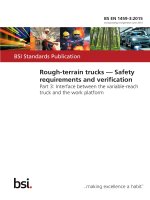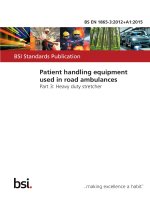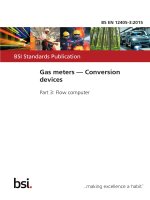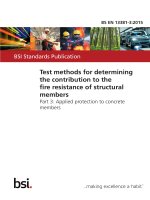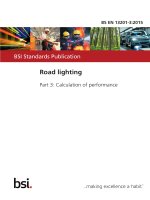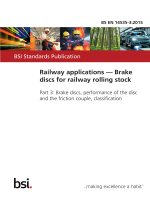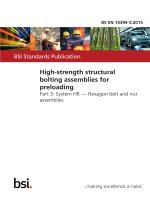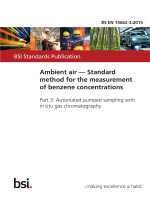Bsi bs en 62271 3 2015
Bạn đang xem bản rút gọn của tài liệu. Xem và tải ngay bản đầy đủ của tài liệu tại đây (1.66 MB, 54 trang )
BS EN 62271-3:2015
BSI Standards Publication
High-voltage switchgear
and controlgear
Part 3: Digital interfaces based
on IEC 61850
BRITISH STANDARD
BS EN 62271-3:2015
National foreword
This British Standard is the UK implementation of EN 62271-3:2015. It
is identical to IEC 62271-3:2015. It supersedes BS EN 62271-3:2006
which is withdrawn.
The UK participation in its preparation was entrusted by Technical
Committee PEL/17, Switchgear, controlgear, and HV-LV co-ordination, to
Subcommittee PEL/17/1, High-voltage switchgear and controlgear.
A list of organizations represented on this committee can be obtained on
request to its secretary.
This publication does not purport to include all the necessary provisions of
a contract. Users are responsible for its correct application.
© The British Standards Institution 2015.
Published by BSI Standards Limited 2015
ISBN 978 0 580 79342 4
ICS 29.130.10
Compliance with a British Standard cannot confer immunity from
legal obligations.
This British Standard was published under the authority of the
Standards Policy and Strategy Committee on 31 May 2015.
Amendments/corrigenda issued since publication
Date
Text affected
BS EN 62271-3:2015
EUROPEAN STANDARD
EN 62271-3
NORME EUROPÉENNE
EUROPÄISCHE NORM
May 2015
ICS 29.130.10
Supersedes EN 62271-3:2006
English Version
High-voltage switchgear and controlgear - Part 3: Digital
interfaces based on IEC 61850
(IEC 62271-3:2015)
Appareillage à haute tension - Partie 3: Interfaces
numériques basées sur l'IEC 61850
(IEC 62271-3:2015)
Hochspannungs-Schaltgeräte und -Schaltanlagen Teil 3: Digitale Schnittstellen nach IEC 61850
(IEC 62271-3:2015)
This European Standard was approved by CENELEC on 2015-04-14. CENELEC members are bound to comply with the CEN/CENELEC
Internal Regulations which stipulate the conditions for giving this European Standard the status of a national standard without any alteration.
Up-to-date lists and bibliographical references concerning such national standards may be obtained on application to the CEN-CENELEC
Management Centre or to any CENELEC member.
This European Standard exists in three official versions (English, French, German). A version in any other language made by translation
under the responsibility of a CENELEC member into its own language and notified to the CEN-CENELEC Management Centre has the
same status as the official versions.
CENELEC members are the national electrotechnical committees of Austria, Belgium, Bulgaria, Croatia, Cyprus, the Czech Republic,
Denmark, Estonia, Finland, Former Yugoslav Republic of Macedonia, France, Germany, Greece, Hungary, Iceland, Ireland, Italy, Latvia,
Lithuania, Luxembourg, Malta, the Netherlands, Norway, Poland, Portugal, Romania, Slovakia, Slovenia, Spain, Sweden, Switzerland,
Turkey and the United Kingdom.
European Committee for Electrotechnical Standardization
Comité Européen de Normalisation Electrotechnique
Europäisches Komitee für Elektrotechnische Normung
CEN-CENELEC Management Centre: Avenue Marnix 17, B-1000 Brussels
© 2015 CENELEC All rights of exploitation in any form and by any means reserved worldwide for CENELEC Members.
Ref. No. EN 62271-3:2015 E
BS EN 62271-3:2015
EN 62271-3:2015
-2-
Foreword
The text of document 17C/617/FDIS, future edition 2 of IEC 62271-3, prepared by
SC 17C "High-voltage switchgear and controlgear assemblies" of IEC/TC 17 "Switchgear and
controlgear" was submitted to the IEC-CENELEC parallel vote and approved by CENELEC as
EN 62271-3:2015.
The following dates are fixed:
•
latest date by which the document has to be
implemented at national level by
publication of an identical national
standard or by endorsement
(dop)
2016-01-14
•
latest date by which the national
standards conflicting with the
document have to be withdrawn
(dow)
2018-04-14
This document supersedes EN 62271-3:2006.
Attention is drawn to the possibility that some of the elements of this document may be the subject of
patent rights. CENELEC [and/or CEN] shall not be held responsible for identifying any or all such
patent rights.
Endorsement notice
The text of the International Standard IEC 62271-3:2015 was approved by CENELEC as a European
Standard without any modification.
In the official version, for Bibliography, the following notes have to be added for the standards indicated:
NOTE
Harmonized as EN 60265 Series .
IEC 60794 Series
NOTE
Harmonized as EN 60794 Series.
IEC 61754-20:2012
NOTE
Harmonized as EN 61754-20:2012 (not modified).
IEC 61850-6:2009
NOTE
Harmonized as EN 61850-6:2010 (not modified).
IEC 61850-7-1:2011
NOTE
Harmonized as EN 61850-7-1:2011 (not modified).
IEC 61850-7-410:2012
NOTE
Harmonized as EN 61850-7-410:2013 (not modified).
IEC 61850-7-420:2009
NOTE
Harmonized as EN 61850-7-420:2009 (not modified).
NOTE
Harmonized as EN 61869-9
NOTE
Harmonized as EN 62271-102:2002 (not modified).
IEC 61869-9
2)
IEC 62271-102:2001
1)
2)
(not modified).
IEC 62271-102:2001/A1:2011 NOTE
Harmonized as EN 62271-102:2002/A1:2011 (not modified).
IEC 62271-102:2001/A2:2013 NOTE
Harmonized as EN 62271-102:2002/ A2:2013 (not modified).
IEC 62271-103
NOTE
Harmonized as EN 62271-103.
IEC 62271-104
NOTE
Harmonized as EN 62271-104.
IEC 62271-202
NOTE
Harmonized as EN 62271-202.
ISO/IEC 7498-1:1994
NOTE
Harmonized as EN ISO/IEC 7498-1:1994
Superseded by EN 62271 Series.
At draft stage.
3)
Withdrawn publication.
2)
1)
IEC 60265 Series
3)
(not modified).
BS EN 62271-3:2015
EN 62271-3:2015
-3-
Annex ZA
(normative)
Normative references to international publications
with their corresponding European publications
The following documents, in whole or in part, are normatively referenced in this document and are
indispensable for its application. For dated references, only the edition cited applies. For undated
references, the latest edition of the referenced document (including any amendments) applies.
NOTE 1 When an International Publication has been modified by common modifications, indicated by (mod), the relevant
EN/HD applies.
NOTE 2 Up-to-date information on the latest versions of the European Standards listed in this annex is available here:
www.cenelec.eu
Publication
Year
Title
EN/HD
Year
IEC 60870-4
1990
Telecontrol equipment and systems Part 4: Performance requirements
HD 546.4 S1
1992
IEC 61850-3
2013
Communication networks and systems
for power utility automation Part 3: General requirements
EN 61850-3
2014
IEC 61850-4
2011
Communication networks and systems
for power utility automation Part 4: System and project management
EN 61850-4
2011
IEC 61850-5
2013
Communication networks and systems for EN 61850-5
power utility automation Part 5: Communication requirements for
functions and device models
2013
IEC 61850-7-2
2010
Communication networks
EN 61850-7-2
and systems for power utility automation Part 7-2: Basic information and
communication structure - Abstract
communication service interface (ACSI)
2010
IEC 61850-7-3
2010
Communication networks and systems for EN 61850-7-3
power utility automation Part 7-3: Basic communication structure Common data classes
2011
IEC 61850-7-4
2010
Communication networks and systems
EN 61850-7-4
for power utility automation Part 7-4: Basic communication structure Compatible logical node classes and data
object classes
2010
IEC 61850-8-1
2011
Communication networks and systems
EN 61850-8-1
for power utility automation Part 8-1: Specific Communication Service
Mapping (SCSM) - Mappings to MMS
(ISO 9506-1 and ISO 9506-2) and to
ISO/IEC 8802-3
2011
BS EN 62271-3:2015
EN 62271-3:2015
-4-
Publication
Year
Title
EN/HD
IEC 61850-9-2
2011
Communication networks and systems for EN 61850-9-2
power utility automation Part 9-2: Specific Communication Service
Mapping (SCSM) - Sampled values over
ISO/IEC 8802-3
2011
IEC 61850-10
2012
Communication networks and systems
for power utility automation Part 10: Conformance testing
2013
EN 61850-10
Year
IEC/TR 61850-90-4 2013
Communication networks and systems for power utility automation Part 90-4: Network engineering guidelines
-
IEC 62271-1
2007
2008
A1
2011
High-voltage switchgear and controlgear - EN 62271-1
Part 1: Common specifications
A1
IEC 62271-100
2008
2009
A1 + corr.
December 2012
2012
High-voltage switchgear and controlgear - EN 62271-100
Part 100: Alternating current circuitA1
breakers
2011
2012
–2–
BS EN 62271-3:2015
IEC 62271-3:2015 © IEC 2015
CONTENTS
FOREWORD ........................................................................................................................... 5
INTRODUCTION ..................................................................................................................... 7
0.1
General ................................................................................................................... 7
0.2
Position of this standard in relation to the IEC 61850 series .................................... 7
1
Scope .............................................................................................................................. 8
2
Normative references ...................................................................................................... 8
3
Terms and definitions ...................................................................................................... 9
4
Normal and special service conditions ........................................................................... 13
5
Ratings and classifications ............................................................................................ 13
5.1
LNs on the process level of a high-voltage substation ........................................... 13
5.2
Communication services ....................................................................................... 15
5.2.1
Conformance classes .................................................................................... 15
5.2.2
ACSI basic conformance statement ............................................................... 15
5.2.3
ACSI models conformance statement ............................................................ 16
5.2.4
ACSI service conformance statement ............................................................ 18
5.3
Timing requirements ............................................................................................. 19
5.3.1
General ......................................................................................................... 19
5.3.2
Opening and closing times for circuit-breakers ............................................... 21
5.4
Data security......................................................................................................... 23
5.5
Data integrity ........................................................................................................ 23
5.6
Performance requirements .................................................................................... 23
5.6.1
Performance classes for reliability ................................................................. 23
5.6.2
Performance classes for availability ............................................................... 23
5.6.3
Performance classes for maintainability ......................................................... 23
5.6.4
Dependability ................................................................................................. 23
5.6.5
Maximum expansion of the network ............................................................... 24
6
Design and construction ................................................................................................ 24
6.1
6.1.1
6.1.2
6.1.3
6.2
6.2.1
6.2.2
6.2.3
6.2.4
6.3
6.3.1
6.3.2
6.3.3
6.3.4
6.4
6.5
6.6
7
Type
General ................................................................................................................. 24
Typical location of switchgear controllers and communication devices ........... 24
Typical system topology ................................................................................ 26
Typical controller system redundancy ............................................................ 30
Technological boundaries ..................................................................................... 30
General ......................................................................................................... 30
Interface point ............................................................................................... 30
Transmission systems ................................................................................... 30
Human machine interface .............................................................................. 31
Mechanical requirements ...................................................................................... 31
Mechanical stresses ...................................................................................... 31
Degree of protection provided by enclosures ................................................. 31
Degree of protection for connectors ............................................................... 31
Accessibility................................................................................................... 31
Electrical requirements ......................................................................................... 31
EMC ..................................................................................................................... 31
Electronic nameplates ........................................................................................... 31
tests ..................................................................................................................... 32
BS EN 62271-3:2015
IEC 62271-3:2015 © IEC 2015
–3–
7.1
General ................................................................................................................. 32
7.2
Switchgear communication interface conformance tests ........................................ 32
7.3
Time measurement of switchgear .......................................................................... 32
7.3.1
Circuit-breakers ............................................................................................. 32
7.3.2
Other switchgear ........................................................................................... 35
8
Routine tests ................................................................................................................. 35
8.1
General ................................................................................................................. 35
8.2
Time measurement on switchgear ......................................................................... 36
9
Information to be given with enquiries, tenders and orders ............................................ 36
10
Rules for transport, storage, installation, operation and maintenance ............................ 36
11
Safety ............................................................................................................................ 36
Annex A (normative) Test overview table ............................................................................. 37
Annex B (normative) Electronic nameplates ......................................................................... 38
B.1
B.2
B.3
B.4
Annex C
General ................................................................................................................. 38
Electronic nameplate for circuit breaker ................................................................ 38
Electronic nameplate for switchgear other than circuit breakers ............................ 40
Presence conditions .............................................................................................. 41
(informative) Test procedures – Performance type testing ..................................... 44
Bibliography .......................................................................................................................... 46
Figure 1 – Calculation of intelligent switchgear operating times (example 1) ......................... 20
Figure 2 – Calculation of intelligent switchgear operating times (example 2) ......................... 20
Figure 3 – Opening/closing command to intelligent switchgear .............................................. 21
Figure 4 – Opening/closing command to switchgear .............................................................. 21
Figure 5 – Opening operation of an intelligent circuit-breaker................................................ 22
Figure 6 – Closing operation of an intelligent circuit-breaker ................................................. 23
Figure 7 – GIS (example 1) ................................................................................................... 24
Figure 8 – Secondary system in medium voltage cubicle (example 2) ................................... 25
Figure 9 – AIS circuit-breaker (example 3) ............................................................................ 26
Figure 10 – AIS circuit-breaker (example 4) .......................................................................... 26
Figure 11 – GIS (example 1) with serial communication network ........................................... 27
Figure 12 – GIS (example 2) with serial communication network ........................................... 28
Figure 13 – AIS circuit-breaker (example 3) with serial communication network .................... 29
Figure 14 – AIS circuit-breaker (example 4) with serial communication network .................... 29
Figure 15 – Performance test of an intelligent switchgear (configuration 1) ........................... 33
Figure 16 – Performance test of an intelligent switchgear (configuration 2) ........................... 34
Figure C.1 – Performance test of an intelligent switchgear – CBC operating time .................. 44
Figure C.2 – Performance test of an intelligent switchgear – CB operating time .................... 45
Table 1 – LNs on process level ............................................................................................. 14
Table 2 – ACSI basic conformance statement ....................................................................... 16
Table 3 – ACSI models conformance statement .................................................................... 17
Table 4 – Additional restrictions for GOOSE ......................................................................... 18
Table 5 – ACSI service conformance statement .................................................................... 19
–4–
BS EN 62271-3:2015
IEC 62271-3:2015 © IEC 2015
Table A.1 – Test overview table ............................................................................................ 37
Table B.1 – Common data class VSD ................................................................................... 38
Table B.2 – New Data Objects added to LN XCBR ................................................................ 39
Table B.3 – New data objects added to LN XSWI .................................................................. 40
Table B.4 – Conditions for application of new data objects .................................................... 41
Table B.5 – Explanations for attributes (1 of 2) ..................................................................... 42
BS EN 62271-3:2015
IEC 62271-3:2015 © IEC 2015
–5–
INTERNATIONAL ELECTROTECHNICAL COMMISSION
____________
HIGH-VOLTAGE SWITCHGEAR AND CONTROLGEAR –
Part 3: Digital interfaces based on IEC 61850
FOREWORD
1) The International Electrotechnical Commission (IEC) is a worldwide organization for standardization comprising
all national electrotechnical committees (IEC National Committees). The object of IEC is to promote
international co-operation on all questions concerning standardization in the electrical and electronic fields. To
this end and in addition to other activities, IEC publishes International Standards, Technical Specifications,
Technical Reports, Publicly Available Specifications (PAS) and Guides (hereafter referred to as “IEC
Publication(s)”). Their preparation is entrusted to technical committees; any IEC National Committee interested
in the subject dealt with may participate in this preparatory work. International, governmental and nongovernmental organizations liaising with the IEC also participate in this preparation. IEC collaborates closely
with the International Organization for Standardization (ISO) in accordance with conditions determined by
agreement between the two organizations.
2) The formal decisions or agreements of IEC on technical matters express, as nearly as possible, an international
consensus of opinion on the relevant subjects since each technical committee has representation from all
interested IEC National Committees.
3) IEC Publications have the form of recommendations for international use and are accepted by IEC National
Committees in that sense. While all reasonable efforts are made to ensure that the technical content of IEC
Publications is accurate, IEC cannot be held responsible for the way in which they are used or for any
misinterpretation by any end user.
4) In order to promote international uniformity, IEC National Committees undertake to apply IEC Publications
transparently to the maximum extent possible in their national and regional publications. Any divergence
between any IEC Publication and the corresponding national or regional publication shall be clearly indicated in
the latter.
5) IEC itself does not provide any attestation of conformity. Independent certification bodies provide conformity
assessment services and, in some areas, access to IEC marks of conformity. IEC is not responsible for any
services carried out by independent certification bodies.
6) All users should ensure that they have the latest edition of this publication.
7) No liability shall attach to IEC or its directors, employees, servants or agents including individual experts and
members of its technical committees and IEC National Committees for any personal injury, property damage or
other damage of any nature whatsoever, whether direct or indirect, or for costs (including legal fees) and
expenses arising out of the publication, use of, or reliance upon, this IEC Publication or any other IEC
Publications.
8) Attention is drawn to the Normative references cited in this publication. Use of the referenced publications is
indispensable for the correct application of this publication.
9) Attention is drawn to the possibility that some of the elements of this IEC Publication may be the subject of
patent rights. IEC shall not be held responsible for identifying any or all such patent rights.
International Standard IEC 62271-3 has been prepared by subcommittee 17C: High-voltage
switchgear and controlgear assemblies, of IEC technical committee 17: Switchgear and
controlgear.
This second edition cancels and replaces the first edition published in 2006. This edition
constitutes a technical revision.
This edition includes the following significant technical changes with respect to the previous
edition:
a) an update to the latest edition(s) of IEC 61850 series;
(e.g. Annex B “LNs for sensors and monitoring” of edition 1 has been deleted since these
LNs are now covered by standard IEC 61850-7-4:2010)
b) an update of normative references;
BS EN 62271-3:2015
IEC 62271-3:2015 © IEC 2015
–6–
c) the minimum voltage range this standard refers to, was changed from 72,5 kV to above
1 kV;
d) the description of performance tests and conformance tests became more specific;
e) the new – informative – Annex C gives an example for performance type testing;
f)
6.2.3 “transmission systems” as well as appropriate subclauses have been superseded by
standard IEC TR 61850-90-4:2013;
g) fibre optical connector type LC becomes only recommended type of fibre optic connector
in accordance with IEC TR 61850-90-4:2013;
h) electronic nameplates have been redefined as extension of LN XCBR and LN XSWI with
data objects, reflecting required additional name plate information.
NOTE A new common data class Visible String Description (VSD) will be added to the IEC 61850-7-3 to support
these new data objects.
This standard has the status of a product family standard and may be used as a normative
reference in a dedicated product standard for highvoltage switchgear and controlgear.
The text of this standard is based on the following documents:
FDIS
Report on voting
17C/617/FDIS
17C/623/RVD
Full information on the voting for the approval of this standard can be found in the report on
voting indicated in the above table.
This publication has been drafted in accordance with the ISO/IEC Directives, Part 2.
A list of all parts in the IEC 62271 series, published under the general title High voltage
switchgear and controlgear, can be found on the IEC website.
The committee has decided that the contents of this publication will remain unchanged until
the stability date indicated on the IEC web site under "" in the data
related to the specific publication. At this date, the publication will be
•
reconfirmed,
•
withdrawn,
•
replaced by a revised edition, or
•
amended.
IMPORTANT – The 'colour inside' logo on the cover page of this publication indicates
that it contains colours which are considered to be useful for the correct
understanding of its contents. Users should therefore print this document using a
colour printer.
BS EN 62271-3:2015
IEC 62271-3:2015 © IEC 2015
–7–
INTRODUCTION
0.1
General
This standard is a product family standard for high-voltage switchgear and controlgear and
assemblies thereof. It provides an application of the horizontal standard series IEC 61850
which details layered power utility communication architecture, in the world of high-voltage
switchgear and controlgear.
By providing tutorial material such as examples and explanations, it also gives an access for
switchgear experts to concepts and methods applied in the IEC 61850 series.
Compared to switchgear equipment, digital communication technology is subject to ongoing
changes which are expected to continue in the future. Profound experience with electronics
integrated directly into switchgear has yet to be gathered on a broader basis, as this type of
equipment is not widely spread in the industry and a change of metabolism has not yet
occurred.
This situation is taken into account in this standard by setting an appropriate validity date and
by specifying several options to most of the communication-related requirements, such as
connectors or fibres.
0.2
Position of this standard in relation to the IEC 61850 series
The IEC 61850 series is a horizontal standard intended to be used for communication and
systems in the power utility. The most important parts of this series define:
1) information models for the power utility automation system.
These information models include both the models of the switchgear (like circuit-breakers
and disconnectors) and other process equipment (like instrument transformers), and the
models of the power utility automation system (like protection relays);
2) the communication between intelligent electronic devices (IEDs) of the power utility
automation system;
3) a configuration language used to describe the configuration aspects of the power utility
automation system;
4) conformance testing of the communication interfaces of the IEDs of the power utility
automation system including their data models.
Typically, IEDs like bay level controllers interface to switchgear. In that case, the data models
of the switchgear are implemented in these devices. However, this is not the only realization.
In the case where electronics are integrated direct into switchgear, the above-mentioned data
models should be implemented within the switchgear and the switchgear supports a
communication interface.
IEC 61850, being a horizontal standard series, leaves many options open in order to support
present and future requirements of all sizes of power utility automation system at all voltage
levels.
–8–
BS EN 62271-3:2015
IEC 62271-3:2015 © IEC 2015
HIGH-VOLTAGE SWITCHGEAR AND CONTROLGEAR –
Part 3: Digital interfaces based on IEC 61850
1
Scope
This part of IEC 62271 is applicable to high-voltage switchgear and controlgear for all rated
voltage levels above 1 kV and assemblies thereof and specifies equipment for digital
communication with other parts of the power utility automation and its impact on testing. This
equipment for digital communication, replacing metal parallel wiring, can be integrated into
the high-voltage switchgear, controlgear, and assemblies thereof, or can be external
equipment in order to provide compliance for existing switchgear and controlgear and
assemblies thereof with the standards of the IEC 61850 series.
This International Standard is a product standard based on the IEC 61850 series. It deals with
all relevant aspects of switchgear and controlgear, and assemblies thereof with a serial
communication interface according to the IEC 61850 series. In particular it defines:
a) a selection of the information models from the IEC 61850 series that are supported by
such switchgear and controlgear, and assemblies thereof;
b) conformance classes for the set of communication services that are supported by the
switchgear and controlgear, and assemblies thereof;
c) modifications and extensions to type and routine tests of switchgear and controlgear, and
assemblies thereof that are required due to the serial communication interface.
The standard specifies the requirements for digital communication equipment used within
high-voltage switchgear, controlgear, and assemblies thereof, as well as the relevant testing
requirements.
The relevant switchgear standards of the IEC 62271 series are applicable in general, with the
additional specifications described in this standard.
NOTE 1 This standard intends to promote interoperability of communication interfaces. Interchangeability is
outside the scope of this standard, as there is no requirement for it. Interchangeability is also outside the scope of
the IEC 61850 series.
NOTE 2 For an introduction to power utility automation communication and the related terms, definitions and
models, refer to IEC 61850-1 which provides an overview of the objectives and requirements of the IEC 61850
series in general. IEC 61850-7-1 provides an overview of modelling techniques.
2
Normative references
The following documents, in whole or in part, are normatively referenced in this document and
are indispensable for its application. For dated references, only the edition cited applies. For
undated references, the latest edition of the referenced document (including any
amendments) applies.
IEC 60870-4:1990, Telecontrol equipment and systems – Part 4: Performance requirements
IEC 61850-3:2013, Communication networks and systems for power utility automation
Part 3: General requirements
–
IEC 61850-4:2011, Communication networks and systems for power utility automation –
Part 4: System and project management
BS EN 62271-3:2015
IEC 62271-3:2015 © IEC 2015
–9–
IEC 61850-5:2013, Communication networks and systems for power utility automation –
Part 5: Communication requirements for functions and device models
IEC 61850-7-2:2010, Communication networks and systems for power utility automation –
Part 7-2: Basic information and communication structure – Abstract communication service
interface (ACSI)
IEC 61850-7-3:2010, Communication networks and systems for power utility automation –
Part 7-3: Basic communication structure – Common data classes
IEC 61850-7-4:2010, Communication networks and systems for power utility automation –
Part 7-4: Basic communication structure – Compatible logical node classes and data object
classes
IEC 61850-8-1:2011, Communication networks and systems for power utility automation –
Part 8-1: Specific communication service mapping (SCSM) – Mappings to MMS (ISO 9506-1
and ISO 9506-2) and to ISO/IEC 8802-3
IEC 61850-9-2:2011, Communication networks and systems for power utility automation –
Part 9-2: Specific communication service mapping (SCSM) – Sampled values over ISO/IEC
8802-3
IEC 61850-10:2012, Communication networks and systems for power utility automations –
Part 10: Conformance testing
IEC TR 61850-90-4:2013, Communication networks and systems for power utility automation
– Part 90-4: Network engineering guidelines
IEC 62271-1:2007, High-voltage switchgear and controlgear – Part 1: Common specifications
IEC 62271-1:2007/AMD1:2011
IEC 62271-100:2008, High-voltage switchgear and controlgear – Part 100: Alternating current
circuit-breakers
IEC 62271-100:2008/AMD1:2012
3
Terms and definitions
For the purposes of this document, the following terms and definitions apply.
3.1
time requirement
maximum acceptable time delay between source and sink
3.2
mandatory data
data where coding is specified and the information always present
Note 1 to entry:
Mandatory data ensures interoperability in power utility automation.
3.3
optional data
data where the coding is specified but the information not necessarily present
3.4
data integrity
ability of a communication system to deliver data from its originator to its destinations with an
acceptable residual error rate
– 10 –
BS EN 62271-3:2015
IEC 62271-3:2015 © IEC 2015
Note 1 to entry: In the case of switchgear with a digital interface, data integrity concerns the probability of
undetected errors resulting in wrong information about actual process states in the monitoring direction or
unintended actions in the control direction of the system.
3.5
interoperability
ability of two or more IEDs from the same vendor, or from different vendors, to exchange
information and use that information for correct execution of specified functions
[SOURCE: IEC TR 61850-1:2013, 3.1.8]
3.6
logical node
LN
smallest part of a function that exchanges data
Note 1 to entry:
A logical node is an object defined by its data and methods.
[SOURCE: IEC TR 61850-1:2013, 3.1.9]
3.7
abstract communication service interface
ACSI
virtual interface to an IED providing abstract communication services, for example,
connection, variable access, unsolicited data transfer, device control and file transfer
services, independent of the actual communication stack and profiles used
[SOURCE: IEC TR 61850-1:2013, 3.1.1]
3.8
intelligent electronic device
IED
any device incorporating one or more processors with the capability to receive or send
data/controls from or to an external source (for example, electronic multifunction meters,
digital relays, controllers)
[SOURCE: IEC TR 61850-1:2013, 3.1.6]
3.9
protocol implementation conformance statements
PICS
summary of the capabilities of the system to be tested
Note 1 to entry: PICS contain information regarding the ACSI. This information could typically be optional parts,
specific restrictions, or add-ons (see IEC 61850-7-2:2010).
[SOURCE: adapted from ISO/IEC 8823-2:1997]
3.10
model implementation conformance statement
MICS
statement which details the standard data object model elements supported by the system or
device
[SOURCE: IEC 61850-10:2012, 3.4]
3.11
service
functional capability of a resource which can be modelled by a sequence of service primitives
BS EN 62271-3:2015
IEC 62271-3:2015 © IEC 2015
– 11 –
Note 1 to entry: A resource in the context of this standard is an IED. A service primitive is an abstract,
implementation independent representation of an interaction between the service user and the service provider.
[SOURCE: IEC TS 61850-2:2003, 2.121, modified – addition of a new note to entry]
3.12
configuration (of a system or device)
step in system design, for example, selecting functional units, assigning their locations and
defining their interconnections
[SOURCE: IEC TS 61850-2:2003, 2.14]
3.13
data security
ability to avoid placing the controlled system in a potentially dangerous or unstable situation
by an undetected error
3.14
reliability
measure of a system or equipment to perform its intended function under specified conditions
for a specified period of time
Note 1 to entry:
It is a probability figure, based on failure data and length of operating time.
[SOURCE: adapted from IEC 60050-191:1990, 191-02-06]
3.15
availability
the ability of an item to be in a state to perform a required function under given conditions at a
given instant of time or over a given time interval, assuming that the required external
resources are provided
Note 1 to entry: This ability depends on the combined aspects of the reliability performance, the maintainability
performance and the maintenance support performance.
Note 2 to entry: Required external resources, other than maintenance resources do not affect the availability
performance of the item.
Note 3 to entry:
In French the term "disponibilité" is also used in the sense of "instantaneous availability".
3.16
maintainability
the ability of an item under given conditions of use, to be retained in, or restored to, a state in
which it can perform a required function, when maintenance is performed under given
conditions and using stated procedures and resources
Note 1 to entry:
The term "maintainability" is also used as a measure of maintainability performance.
3.17
dependability
collective term used to describe the availability performance and its influencing factors:
reliability performance, maintainability performance, and maintenance support performance
[SOURCE: IEC 60050-191:1990, 191-02-03]
3.18
communication conformance test
check of data flow on communication channels in accordance with the standard conditions
concerning access organization, formats and bit sequences, time synchronization, timing,
signal form and level and reaction to errors
– 12 –
BS EN 62271-3:2015
IEC 62271-3:2015 © IEC 2015
Note 1 to entry: The conformance test can be carried out and certified to the standard or to specifically described
parts of the standard.
Note 2 to entry: The term "communication" has been added to "conformance test" in order to state that this test
refers to communication conformance.
3.19
performance test
test on complete intelligent switchgear system to characterize it under operating conditions
3.20
intelligent switchgear
switchgear composed of its primary part, its mechanism and one or more switchgear
controllers containing at a minimum set of logical nodes according to the IEC 61850 series
Note 1 to entry:
Minimum set of logical nodes are as per 5.1. of this standard.
3.21
switchgear controller
IED with an interface according to IEC 61850-8-1:2011
Note 1 to entry:
A switchgear controller can be:
•
a circuit-breaker controller (abbreviated as CBC in this standard);
•
a disconnector controller (abbreviated as DCC in this standard);
•
an earthing switch controller (abbreviated as ESC in this standard);
•
a controller of another type of switchgear.
3.22
intelligent sensor
sensor with a processor and communications interface according to the IEC 61850 series
EXAMPLE An interface according to IEC 61850-9-2:2011, used for current and voltage measurement via a merging
unit as specified within IEC 61869-9. 1
3.23
communication device
equipment used for interconnection of several IEDs
Note 1 to entry: The term “communication switch” is used in this standard in order to distinguish this type of
equipment from switches as defined in IEC 62271-103:2011. Such a communication switch is used in local area
communication networks to combine communication network segments with different communication hardware,
such as copper- based and fibre optic serial communication networks. The defined data rate is available on every
network segment in parallel. A communication switch is a device which implements layers 1 and 2 of the ISO/OSI
reference model according to ISO/IEC 7498 series.
Note 2 to entry: A communication gateway is a communication device used for interconnection of several IEDs
which may use completely different communication methods (for example, one IED with proprietary communication
and another IED with communication according to IEC 61850 series). A communication gateway is a device which
implements all 7 layers of the ISO/OSI communication reference model according to ISO/IEC 7498 series.
Note 3 to entry:
The communication device does not provide for application functionality.
3.24
test device
equipment used for generation of test signals and/or test functions
3.25
test object
device under test
———————
1 To be published.
BS EN 62271-3:2015
IEC 62271-3:2015 © IEC 2015
4
– 13 –
Normal and special service conditions
Clause 2 of IEC 62271-1:2007/AMD 1:2011 giving service conditions, such as ambient air
temperature, altitude is applicable.
5
5.1
Ratings and classifications
LNs on the process level of a high-voltage substation
According to the number of functions integrated in the switchgear, a choice of LNs, among
those given in IEC 61850-5:2013, can be implemented. This standard describes a minimum
requirement if the relevant functions are present.
NOTE 1 LNs are one of the basic concepts of the IEC 61850 series. They can be seen as containers of data
within an IED. LNs are compatibly defined in IEC 61850-7-4:2010 in order to achieve interoperability between IEDs.
For further information, IEC 61850-7-1:2011 is referred to.
NOTE 2 For example, a circuit-breaker controller of an intelligent circuit-breaker implements the LN XCBR.
Should that circuit-breaker controller also implement a synchrocheck function, the LN RSYN would also be
included. Apart from that, sampled values are subject to IEC 61850-9-2:2011.
The LNs as given in Table 1 shall be used to model the communication interface of the
relevant switchgear functions; they are mandatory in the case where the function is present
and it has a serial communication interface:
NOTE 3 The LNs given in Table 1 are taken from IEC 61850-7-4:2010. The column “Purpose and explanation”
gives requirements and explanations to fit into the context of this standard.
BS EN 62271-3:2015
IEC 62271-3:2015 © IEC 2015
– 14 –
Table 1 – LNs on process level
Logical node
Name
Purpose and explanation
Alarm handling (creation of group alarms
and group events)
CALH
This LN shall be used to handle alarms and events
LN zero
LLN0
This LN shall be used to address common data for
logical devices
(mandatory for every logical device)
NOTE 1 According to IEC 61850-7-2:2010, a logical
device can be seen as a composition of LNs and
communication services.
A logical device is not a switching device.
NOTE 2 Communication services are the means to
access the data which reside in LNs.
LN physical device
LPHD
(mandatory for every physical device)
Circuit-breaker
This LN shall be used to model common data for
physical devices
NOTE A physical device according to IEC 61850-72:2010 is an IED (such as a circuit-breaker controller),
not a switching device.
XCBR
This LN shall be used for modelling circuit-breakers
NOTE If there is a single-phase circuit-breaker, this LN
has an instance per phase. These three instances may
be allocated to multiple physical devices.
All kinds of switchgear except circuitbreakers, such as:
XSWI
Switch-disconnectors
This LN shall be used for modelling all kinds of
switchgear except circuit-breakers
NOTE If there is a single-phase switchgear (not a
circuit-breaker), this LN has an instance per phase.
These three instances may be allocated to multiple
physical devices.
Disconnectors
Earthing switches
High-speed earthing switches
Insulation medium supervision (gas)
SIMG
This LN shall be used to supervise the gas volumes of
GIS (gas-insulated switchgear) regarding density,
pressure, temperature, etc.
Monitoring and diagnostics for arcs
SARC
This LN shall be used to supervise the gas volumes of
GIS regarding switching faults or fault arcs
Monitoring and diagnostics for partial
discharge
SPDC
This LN shall be used to supervise the gas volumes of
GIS regarding signatures of partial discharges
Circuit-breaker monitoring
SCBR
This LN shall be used specifically for circuit-breaker
monitoring
Monitoring of all kinds of switchgear
except circuit-breakers, such as:
SSWI
This LN shall be used specifically for circuit switch
monitoring of all kinds of switchgear except circuitbreakers
Switch-disconnectors
Disconnectors
Earthing switches
High-speed earthing switches
The use of these nodes should also be considered for situations where the monitoring
equipment is located remotely from the switchgear being monitored and for the communication of manufacturer-specific data.
Where additional data above that specified in the IEC 61850 series is required for the
monitoring of insulation, arcs and partial discharge, this shall be achieved by the extension of
the LNs SIMG, SARC and SPDC as specified in IEC 61850-7-4:2010.
BS EN 62271-3:2015
IEC 62271-3:2015 © IEC 2015
5.2
– 15 –
Communication services
5.2.1
Conformance classes
The standards of the IEC 61850 series specify a large set of communication services. Not all
of these services are used to operate switchgear; many of these services support additional
capabilities such as configuration and supervision of an IED.
NOTE 1 Communication services are used to access and exchange data residing in logical nodes via a serial
communication network according to the IEC 61850 series.
Therefore, not all of the services defined in the IEC 61850 series need to be implemented in
an IED. The services that are required to be implemented are defined in terms of
conformance classes within this clause. The conformance classes are defined using the ACSI
conformance statements specified in IEC 61850-7-2:2010, Annex A. The following
conformance classes are defined:
•
class a: the minimal set of services required to operate switchgear;
NOTE 2
The intention of conformance class “a” is to allow very simple devices; i.e. “GOOSE-only-devices”.
•
class b: the services required to implement the complete IEC 61850 series’ data model
with self-descriptive capabilities;
•
class c: the implementation of all services that are applicable for the specific LN. This
includes configuration capabilities, file transfer and log.
There is no requirement for a switchgear controller of a given conformance class to implement
a certain LN or not.
NOTE 3 The services within the IEC 61850 series are defined using an abstract object-modelling technique.
Abstract means that this definition is focused on the description of what the services provide.
NOTE 4 Logical nodes and services within the IEC 61850 series provide means to retrieve comprehensive
information about the information model and the services that operate on the information models, i.e. about
themselves. This capability is called self-description.
NOTE 5 File transfer can be used to transmit information such as travel curves or configuration information via
the communication network.
NOTE 6 Logging is a communication facility within the IEC 61850 series which can be used for the transmission
of, for example, a sequence of events, from an IED to a human machine interface for the purpose of maintenance
of a substation.
5.2.2
ACSI basic conformance statement
The ACSI is described within IEC 61850-7-2:2010 in detail. The conformance classes related
to intelligent switchgears are given in Table 2.
NOTE 1 ACSI is the abstract communication service interface for IEDs as defined in IEC 61850-7-2:2010. It is
defined in an abstract way and thus independent of the underlying communication architecture.
NOTE 2 ACSI conformance statements are used to provide an overview and details about IEDs claiming
conformance with ACSI.
NOTE 3 The mapping to the communication protocol defined by the ISO/IEC 8802-3:2000 (Ethernet)/TCP/IP/MMS
standard is called SCSM (specific communication service mapping) and is defined in IEC 61850-8-1:2011, and
IEC 61850-9-2:2011, where IEC 61850-9-2:2011 considers the exchange of sampled values. Therefore, sampled
values are outside the scope of this standard.
NOTE 4 TCP/IP means transport control protocol/internet protocol. MMS means manufacturing message
specification.
NOTE 5 The client-server model as mentioned in Table 2 is one of the basic concepts for data exchange
according to the IEC 61850 series. A client is defined as a requester of communication services and a server is
defined as the provider of communication services. The client-server model is most commonly used for the
exchange of alarms and events.
NOTE 6 The GSE or generic substation event model is another basic concept of data exchange according to the
IEC 61850 series. It provides fast and reliable distribution of data between IEDs. It can be used for the exchange
– 16 –
BS EN 62271-3:2015
IEC 62271-3:2015 © IEC 2015
of, for example, binary status information used for interlocking purpose, or trip signals. Data is made available to
the communication network by a publisher; subscribers receive this data without further request. The generic
substation event provides the peer-to-peer information exchange between the input data values of one IED to the
output data of many other IEDs (multicast, peer-to-peer communication).
NOTE 7 The SVC or sampled value control model is used for the fast exchange of measurands, for example,
between a non-conventional current sensor and a protection device. This type of data exchange is outside the
scope of this standard.
NOTE 8 The first two columns in Table 2 are taken from IEC 61850-7-2:2010. The first column is used to
enumerate the different basic conformance requirements. B stands for “basic” as used in “ACSI basic conformance
statement”.
NOTE 9 For further details, see IEC 61850-7-2:2010, A.2.
Table 2 – ACSI basic conformance statement
Conformance
class
Client-server roles
a
b
c
B11
Server side (of TWO-PARTY-APPLICATION-ASSOCIATION)
-
M1
M1
B12
Client side (of TWO-PARTY-APPLICATION-ASSOCIATION)
-
-
-
SCSMs supported
B21
SCSM: IEC 61850-8-1 used
O
O
O
B23
SCSM: IEC 61850-9-2 used
O
O
O
B24
SCSM: other
-
-
-
Generic substation event model (GSE)
B31
Publisher side
M
M
M
B32
Subscriber side
M
M
M
Transmission of sampled value model (SVC)
B41
Publisher side
O
O
O
B42
Subscriber side
O
O
O
M
– mandatory
M1 – mandatory, if support for logical device model has been declared
O
– optional
5.2.3
/
–
– not required
ACSI models conformance statement
The ACSI models conformance statement is described within Annex A of IEC 61850-7-2:2010
in detail. The conformance statement related to intelligent switchgears are given in Table 3.
NOTE 1 ACSI is the abstract communication service interface for IEDs as defined in IEC 61850-7-2:2010. It is
defined in an abstract way and thus independent of the underlying communication architecture.
NOTE 2 ACSI conformance statements are used to provide an overview and details about IEDs claiming
conformance with ACSI.
NOTE 3 The first two columns in Table 3 are taken from IEC 61850-7-2:2010. The first column (M1 to M17) is
used to enumerate the different models conformance requirements. M stands for “models” as used in “ACSI models
conformance statement”.
NOTE 4 A report can be used to transmit events or alarms from an IED via the communication system to an HMI.
The specific characteristic of the buffered report control is basically that it buffers the event data as they occur until
their transmission over the communication network is completed. Unbuffered report control does not provide this
functionality. In case of, for example, a communication interruption, the event data would be lost.
NOTE 5 GOOSE (generic object oriented substation event) is the way to realize GSE (see Note 6 to 5.2.2).
NOTE 6 The other model requirements cannot be described here in an exhaustive way. For further information,
IEC 61850-7-1:2011 is referred to.
BS EN 62271-3:2015
IEC 62271-3:2015 © IEC 2015
– 17 –
NOTE 7 For further details about the models conformance statement, see IEC 61850-7-2:2010, A.3.
Table 3 – ACSI models conformance statement
Conformance class
a
b
c
M1
Logical device
C1
M
M
M2
Logical node
C1
M
M
M3
Data
-
M
M
M4
Data set
-
M
M
M5
Substitution
-
O
O
M6
Setting group control
O
O
O
If server side (B11) is supported
Reporting
Buffered report control
M7
O
O
M7-1
sequence-number
-
O
O
M7-2
report-time-stamp
-
O
C2
M7-3
reason-for-inclusion
-
O
O
M7-4
data-set-name
-
O
O
M7-5
data-reference
-
O
O
M7-6
buffer-overflow
-
O
O
M7-7
entryID
-
O
O
M7-8
BufTim
-
O
O
M7-9
IntgPd
-
O
O
M7-10
GI
-
O
O
M7-11
conf-revision
O
O
-
O
O
Unbuffered report control
M8
M8-1
sequence-number
-
O
O
M8-2
report-time-stamp
-
O
C3
M8-3
reason-for-inclusion
-
O
O
M8-4
data-set-name
-
O
O
a
b
c
O
Table is continued on following page
M8-5
data-reference
-
O
M8-6
BufTim
-
O
O
M8-7
IntgPd
-
O
O
M8-8
GI
-
O
O
M8-9
conf-revision
O
O
O
O
O
O
Logging
Log control
M9
M9-1
-
IntgPd
M10
Log
-
O
O
M11
Control
-
M
M
M
M
M
If GSE (B31/32) is supported
M12
GOOSE
If SVC (B41/42) is supported
M14
Multicast SVC
O
O
O
M15
Unicast SVC
O
O
O
Time
M
M
M
File transfer
-
O
O
For all IED’s
M16
M17
M
– mandatory
O
– optional
C1
– not required
– shall be M, if support for M6 “setting group control” is declared
C2
– shall be M, if support for M7 “buffered report control” is declared
C3
– shall be M, if support for M8 “unbuffered report control” is declared
BS EN 62271-3:2015
IEC 62271-3:2015 © IEC 2015
– 18 –
The following applies to all switchgear controllers of a given conformance class: If the
switchgear controller implements information in the LNs in the column “LN” of Table 4 then
the data mentioned in the column “Data that is mandatory to be included in the GOOSE
message” of Table 4 shall be included in the data set which is the basis for the GOOSE
message / messages of this switchgear controller.
Table 4 – Additional restrictions for GOOSE
LN
Data that is mandatory to be included
in the GOOSE message
CALH
LN group control: Alarm handling
Beh, Health, GrAlm
LLN0
LN group system: Logical node zero
Beh, Health
LPHD
LN group system: Physical device
information
PhyHealth
XCBR
LN group for switchgear: Circuit breaker
Beh, Health, EEHealth, Loc, Pos, BlkOpn, BlkCls,
CBOpCap
XSWI
LN group for switchgear: Circuit switch
Beh, Health, EEHealth, Loc, Pos, BlkOpn, BlkCls,
SwOpCap
SIMG
LN group for supervision and monitoring:
Beh, Health, InsAlm, PresAlm a , DenAlm a , TmpAlm a
Insulation medium supervision (gas)
a
Depends on the supervised properties of the insulation gas, at least one alarm shall be present.
NOTE 8 In the following, a short description of the data to be included in a GOOSE message is given. For a more
detailed description, see IEC 61850-7-4:2010. Enumerated items are sorted by order of appearance in Table 4.
1.
Beh: behaviour of the LN
2.
Health: health information reflecting the state of the LN related hardware and software (i.e., red-yellow-green
indication)
3.
GrAlm: grouped alarm, assigned via configuration
4.
PhyHealth: health information reflecting the state of the IED
5.
EEHealth: external equipment health (in this standard: health, for example, of circuit-breaker controlled via
LN XCBR)
6.
Loc: control authority = local
7.
Pos: position of switchgear (for example, open-close for a circuit-breaker)
8.
BlkOpn: block open operation
9.
BlkCls. block close operation
10.
MechHealth: mechanical behaviour alarm
11.
CBOpCap: circuit-breaker operation capability
12.
SwOpCap: operation capability for switchgear (not circuit-breaker)
13.
InsAlm: insulation alarm
14.
PresAlm: pressure alarm
15.
DenAlm: density alarm
16.
TmpAlm: temperature alarm
For all data objects mentioned above, both stVal and q at a minimum shall be included in the
GOOSE message.
NOTE 9 The stVal attribute describes the status value of the data (for example, open/close for circuit-breaker
position). The q.validity is part of the quality attribute describing the validity of the data: data becomes invalid, for
example, in the case of an oscillating input or a failure of the input contact. More detailed information on attributes
can be found in IEC 61850-7-3:2010.
5.2.4
ACSI service conformance statement
NOTE 1 ACSI is the abstract communication service interface for IEDs as defined in IEC 61850-7-2:2010. It is
defined in an abstract way and is thus independent of the underlying communication architecture.
BS EN 62271-3:2015
IEC 62271-3:2015 © IEC 2015
– 19 –
NOTE 2 ACSI conformance statements are used to provide an overview and details about IEDs claiming
conformance with ACSI.
NOTE 3 The first two columns in Table 5 are taken out of IEC 61850-7-2:2010. The first column (S35 to S39) is
used to enumerate the different service conformance requirements. S stands for “service” as used in “ACSI service
conformance statement”.
If an ACSI model as described in 5.2.3 is supported, the service conformance shall be as
defined in A.4 of IEC 61850-7-2:2010.
For a class ‘a’ device, the ACSI service conformance statement shall be as follows.
Table 5 – ACSI service conformance statement
Services
Conformance class ‘a’
S35
SendGOOSEMessage
Mandatory
S36
GetGoReference
Optional
S37
GetGOOSEElementNumber
Optional
S38
GetGoCBValues
Optional
S39
SetGoCBValues
Optional
For class ‘b’ and class ‘c’ devices, the details of the ACSI service conformance statement
shall be specified by the manufacturer.
5.3
5.3.1
Timing requirements
General
The manufacturer shall specify the time performance of the intelligent switchgear. For this, the
manufacturer shall declare where the interface point A (connection point for an external
connection according to Figure 1 and following figures) is located. Communication devices
may be from different manufacturer. All timing performances shall be specified with reference
to this interface point. See 6.1 for further explanation.
The time performance, identified as t 3 (intelligent switchgear total operating time) in Figure 1
or Figure 2, shall include t 1 (total processing delay of the communication device [if
applicable], and the switchgear controller), and t 2 (switchgear operating time). For these time
delays, see Figure 1 or Figure 2. For calculation of the overall operation time the timing
performance of external IED’s and the network shall be considered in addition. IED- and
switchgear controller performance classes as specified in IEC 61850-5:2013, Clause 11, need
to be considered. The time performance is calculated from the reception of the first message
(of GOOSE-message containing trip command) at interface point A (see Figure 1, Figure 2,
Figure 3), until the operation of the switchgear. The operation time of the switchgear is
opening time according Figure 5 and closing time as specified in Figure 6.
For communication devices or switchgear controllers that are supplied independent of the
switchgear, for example for use on retrofitting projects, the system integrator shall specify the
total processing delay t 1 including the processing delay of the communication device and if
applicable any controlgear.
BS EN 62271-3:2015
IEC 62271-3:2015 © IEC 2015
– 20 –
Communication
A
Intelligent switchgear
Switchgear
controller
(for example,
DCC, CBC)
Com device
B
Operation
of the
switchgear
t1
t2
t3
Key
A
B
DCC
CBC
t1
t2
External connection
Internal connection
Disconnector controller
Circuit-breaker controller
Total processing delay
Switchgear operating time
Intelligent switchgear total operating time
Serial link according to IEC 61850-8-1 (mandatory)
Serial link according to IEC 61850-8-1 (optional)
t3
IEC
Figure 1 – Calculation of intelligent switchgear operating times (example 1)
Figure 1 shows a timing calculation example for the case of a GIS (gas-insulated switchgear)
bay as shown in Figure 11 or an AIS (air-insulated switchgear) bay as shown in Figure 14.
NOTE 1
In Figure 1, the abbreviation “com device” is short for communication device. See 3.23 for a definition.
NOTE 2
Switchgear equipment and communication device can be from different suppliers.
Figure 2 shows a timing calculation example for the case of a GIS bay as shown in Figure 12
or an AIS bay as shown in Figure 13.
Intelligent switchgear
A
Switchgear
controller
(for example,
DCC, CBC)
B
t1
Operation
of the
switchgear
t2
t3
Key
A
B
DCC
CBC
External connection
Internal connection
Disconnector controller
Circuit-breaker controller
t1
t2
t3
Total processing delay
Switchgear operating time
Intelligent switchgear total operating time
Serial link according to IEC 61850-8-1 (mandatory)
IEC
Figure 2 – Calculation of intelligent switchgear operating times (example 2)

